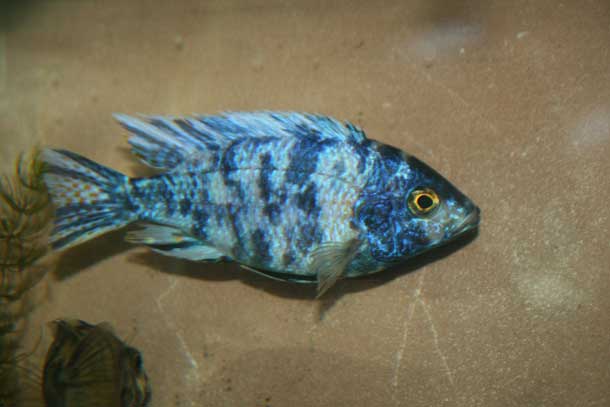The top photo is of a young (about 4 months old) male Blue OB Peacock Cichlid. The bottom photo is a young female, probably the male’s half-sister, of the same age.
This is a domestic (commercial) strain we developed starting in 2003 from fish we acquired from a Florida fish farm. From those original fish we have developed several color varieties. In some of the strains, such as our Gold OB and Orange OB lines, the females are attractive as well. In the Blue OBs, I’ve found that ugly females produce the best males. By best males, I mean those with light and dark blue mottling throughout the body and fins. I don’t mind some orange spangles in the caudal and anal fins, but like the nice dark blue blotching on the sky blue body. Unfortunately, every time I’ve selected for color on the females, I’ve gotten crummy males with faded out dark blue and black mottling and have lost the sky blue underlying color. I’ve learned my lesson and select females that look like the pictured one.
Now for some genetics. In Peacock Cichlids, which are hybrids of Lake Malawi cichlids and have been around for decades, the OB pattern (blotching) is a dominant gene. As a result, our breeding colony of Blue OBs, which usually consists of 6 males and 40-50 females, sometimes throws non-OBs. The non-OBs are Blue Peacocks, a pretty fish in its own right. The incidence of non-OBs has declined in each generation since just by chance most of our breeders are homozygous for OB now. This is because the non-OBs are removed from the breeding colony causing the frequency of the recessive gene for non-OB to be reduced. Someday, as I replace breeders, none of the breeders will carry the non-OB recessive and that color pattern will be purged from the population.



Donte Foreman says
can i be notified when the Blueberry ob peacocks are for sale?
Charles Clapsaddle says
Donte,
I’m very sorry for the tardy response. I just saw this message.
When we have them available, they are listed under the name Blue OB Peacock on the Shop page of this website.
Charles